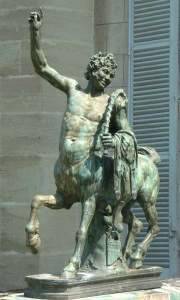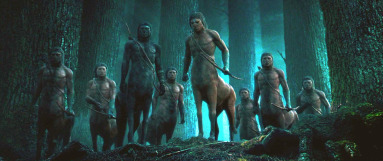A Thing or Two About Centaurs
The most popular theory of how this mythical creature came about was when the Minoans, a people who lived��around 2700-1400 BC, first saw a tribe of nomads. The Minoans were a non-riding culture; the nomads were great horsemen. To the eyes of the Minoans, watching horse and man move so fluidly together, it looked as if they were one creature.
According to Greek myth, the first centaur was the child of Ixion (king of the Lapiths) and Nephele (a nymph cloud disguised to look like Hera). Zeus wished to test Ixion, whom he knew desired his own wife, Hera. Thus he sent the cloud to him in the appearance of Hera. When Ixion succumbed to the temptation, Zeus punished him by making his offspring a strange and hideous half-breed: the centaur.
Kentaurides, or female centaurs, did not appear in the earliest Greek mythology. However, they began to show up in later antiquity, though not often.
Historically, there was much strife between man and centaur. Zeus was known to send centaurs to punish both gods and humans who had offended him.
Though Chiron is one of the best known of all mythical centaurs, his knowledgeable and honorable character was rather in contrast to most stories of centaurs, in which they are rowdy, drunken, and even sometimes evil.
Many say the centaur represents the struggle within each of us between good and evil, god and beast. Others see the centaur quite differently: as a pure symbol of wisdom, foresight and knowledge.
The ancient Thessalian tribes claimed that the horses they bred and raised were descended from the race of centaurs.
The Greek writer Homer refers specifically to a centaur (kentauros) in the Odyssey. However, in other of his
 writings, he calls them ���pheres��� (beasts), which might have meant he was merely referring to a horse and rider (alluding to the savagery of the man riding the horse, or perhaps the horse, or ���beast,��� itself).
writings, he calls them ���pheres��� (beasts), which might have meant he was merely referring to a horse and rider (alluding to the savagery of the man riding the horse, or perhaps the horse, or ���beast,��� itself).In the first century BC, a man named Lucretius actually went so far as to lay out specific reasons denying the existence of centaurs (which means, of course, that many must have believed in their existence to begin with!).��His argument hinged on the different rates of growth between a man and horse. A horse that is three is in the prime of life, whereas a man of only three is ��� well, not a man, but a baby. Therefore a hybrid man-beast would be impossible.
Indian mythology shows ���evidence��� of centaurs (or something very similar). Ancient art and sculptures from India show images of horses with the torso of a man where the horse-head should be.
Not many know where the Greek word ���kentauros��� came from originally. Translated literally, it means ���piercing bull-slayer��� or ���piercing bull-sticker,��� which some argue could have been describing something as simple as a group of men mounted on horses, shooting with bows and arrows at a herd of bulls.
At the University of Tennessee there is an exhibit called ���Centaur from Volos.��� Made by sculptor Bill Willers, the exhibit is a combination of a human skeleton and the skeleton of a Shetland pony. It was originally made with the intention of misleading students, in order to make them more ���critically aware.��� Yikes.
Two of my favorite centaurs: Roonwit, from Narnia (The Last Battle), and Firenze, from the Harry Potter series. Both of these centaurs are depicted as future-seers, star-gazers, as wise and kind and brave.
I chose to make the centaurs in my book wise and kind as well. Yet I can’t help seeing the possibilities of using centaurs in fiction��a different��sense, now I’ve researched them a bit more. The fact that some people saw centaurs as creatures that represented the struggle between good and evil, god and man … what ideas that inspires!
What do you think?

Published on January 26, 2015 05:00
No comments have been added yet.




